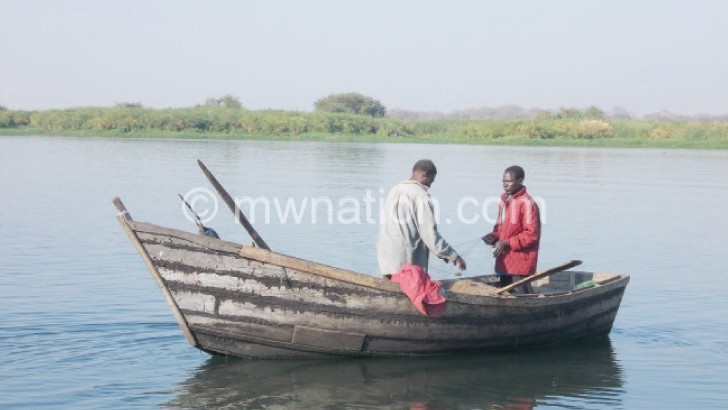Sorrows of artisanal fishers
It is windy and showering in Malindi, a fishing hotspot in Mangochi District on the southern tip of Lake Malawi. Yusuf Kalanje, 45, is already two kilometres in the freshwater lake on a rickety dugout canoe to pull out gill nets he did set the previous evening.
With no life jacket, he braves the storms as fishing is his main source of livelihood for his family.
“Catches are declining,” he says, blaming overfishing, environmental degradation and dwindling water levels.
The falling levels of the lake keep disadvantaging the fisherfolk who cannot afford modern deep-water fishing equipment.

The well-off fishers use trawl, seine and lift nets towed by engine boats. They catch between two and four tons a day in waters 50 to 130 metres deep.
The catch depends on weather, efficiency and depth trawled, they say.
Kalanje is a small-scale artisanal fisher who uses low-cost fishing gear, especially gill nets, long lines, chilimira and cast s nets in open waters no deeper than 20 metres. His kind constitutes almost 90 percent of fishers in the country.
They are vulnerable and a threat to sustainable management and conservation of fish in Malawi’s open-access fishing ground.
Stanley Mvula’s study on community governance and decentralisation in participatory fisheries management shows that the majority of small-scale fishers are clustered in shallow waters.
This, according to the researcher at Centre for Environmental Policy and Advocacy (Cepa, endangers small fishes that are not supposed to be caught prematurely.
To protect young fish, government bans fishing in Lake Malawi and Lake Malombe from October to December.
This allows fish to breed without interference.
During the closed season, catching kasawala, fish below 15 centimetres long, is illegal. Fishers have to abide by the ban and return small fish into the waters. Those found selling and possessing outlawed fish face fines and prosecution.
“It is becoming difficult to sustainably conserve fish stocks with the rampant use of under-meshed fishing gear and disregard of annual bans due to weak enforcement and co-management,” says Mvula.
The Fish project, funded by USAid, is empowering local communities to take the lead in conserving fish.
The locally managed interventions include formulation of by-laws in an effort to rebuild fish stocks in respective areas.
Prescribed mesh size for gillnets is 95 millimetres. Any adjustments are illegal.
According to Kalanje, most fishers are tampering with mesh sizes to maximise catches.
“The recommended mesh sizes hardly catch enough,” he says.
But this leads to overfishing and denies young fish a chance to grow.
The changes in fishing patterns come to environmental degradation that has left rivers and lakes buried in silt and with low water levels.
Destruction of fish breeding grounds due to unregulated deforestation, farming on riverbanks and other environment-unfriendly activities in the upland communities has increased soil erosion and chemical pollution in water systems.
This is altering the natural setting and food chains for fish, resulting in disappearance of key species, including chambo, and a surge in usipa and other smaller species.
However, scientists say that over 33 000 tonnes of ndunduma fish remain unexploited in deep parts of Lake Malawi due to lack of enabling equipment as fishers overcrowd shallow zones.
Government is promoting deep water fishery through public-private partnerships and providing appropriate technologies.
However, many artisanal fishers view this narrative with sceptics.
Kalanje says artisanal fishers wish to upgrade to either semi-commercial or large-scale fishers, but lack equipment and capital to do so.
“Such equipment is beyond reach of many ordinary fishers. I wish we had access to loans and grants from government,” he says.
Between 2005 to 2011, the Fisheries Department, with funding from the African Development Bank (AfDB), provided engine boats and modern fishing units to small-scale fishers venturing in deep-water fishing.
The project ended with marginal success. Currently, Malawi Investment and Trade Centre (Mitc) have bankable investment projects for deep-water fishery, aquaculture, construction of fish processing and value-addition facilities across the country.
However, the uptake remains slow.
Meanwhile, thousands of artisanal fishers like Kalanje are desperate for future livelihoods as catches keep declining due to continued degradation of coastal environments and limited opportunities for deep-water fishing. n





